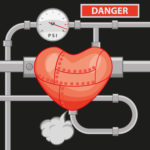Everyone gets headaches at some time or another in their life—some more frequently than others, and some more intensely than others.
Headaches are classified as primary or secondary. Examples of primary headaches are tension headaches, migraines, and cluster headaches. There are a lot of moving parts as to how and why primary headaches occur, but no one-size-fits-all reason that fits for every headache. Generally speaking, there is overactivity of the various tissues, blood vessels, and nerves on and in the head, along with various chemical changes inside the brain that may also contribute. More on all this in a bit.
Secondary headaches come about as symptoms of other conditions, such as a sinus headache, alcohol hangover headache, flu, concussion, dehydration, and hunger to name a few. Secondary headaches are simple to identify, and oftentimes simply vanish when the primary cause of the headache has subsided, i.e. recovery from a cold or the flu, drinking more water, eating a meal, etc.
For purposes of this article, we’ll move on from secondary headaches and focus mostly on the primary headaches. And as primary headaches go, we’ll begin with the most debilitating type: migraines.
Migraines have four stages: prodrome, aura, migraine attack, and postdrome.
The prodrome phase lasts anywhere from hours to days, and includes symptoms such as fatigue, nausea, sensitivity to light, muscle stiffness, irritability, and trouble sleeping to name a few.
The aura can range from several minutes to an hour, and only affects about 1/4 of all migraine suffers. It is a disturbance that may affect vision, other senses, and speech and occurs before or during a migraine. Visual disturbances during an aura can be spots, zigzags or crescents, flashes of light, and temporary partial or full visual loss.
The actual migraine attack is debilitating and can render a person helpless to do much else other than rest (or attempt to) for several hours or as long as three days. Common symptoms experienced during migraine attacks are icepick-like stabbing pains, throbbing, nausea, vomiting, and sensitivity to light and noise.
The postdrome phase of a migraine can last up to a couple days and is characterized by fatigue, depression or euphoria, inability to concentrate, and a lack of comprehension. I’ve heard postdrome describe as a migraine hangover.
The majority of migraines, also known as common migraines, do not include the aura stage and simply come on without warning.
Other types of migraines are the following:
Migraines without head pain (also known as an aura without headache) – pretty self-explanatory, but this type includes all the symptoms of a normal migraine, but without the headache aspect.
Hemiplegic migraine – commonly mistaken for a stroke. Sufferers of hemiplegic migraines experience weakness, numbness, tingling, and visual disturbances on one side of the body. It can last a couple hours or a couple days, and does not always include head pain.
Retinal or ocular migraine – affects women more than men, and mostly during the childbearing years. It is characterized by temporary loss of vision in one eye that lasts as little as minutes or as long as multiple days. This migraine is unique in that it can simply be the aura of a more serious migraine, or it won’t progress beyond the vision loss. I have a family member who experiences retinal migraines, and from her experience it seems to mimic the migraine without headache, but with a more debilitating aura.
Chronic migraine – when you experience a migraine for 15 or more days a month, it is classified as a chronic migraine. These can be mistaken for sinus headaches or tension headaches, and the headache intensity can vary from day to day.
Tension headaches are not migraines, but they are the most common type of headache. They are characterized by a dull ache that acts like a tight band around the head and tender scalp, neck, and shoulders. They can be episodic and last minutes to a week or they can be chronic lasting more than 15 days in a single month.
Cluster headaches not as common as tension headaches or migraines, but they can be just as debilitating and painful. They don’t last as long either, but they can come on daily for weeks or months at a time and are often mistaken for seasonal allergies. They affect one side of the head at a time, with intense head pain, a red or teary eye, runny nose, and flushed or sweating face.
Causes of headaches are endless, with stress being at the top of the list, especially in the case of tension headaches. Bad diet, not enough sleep, and trauma are other common causes.
There is, however, one cause not commonly known, and it is a cause that we chiropractors deal with specifically: the vertebral subluxation.
A vertebral subluxation is a misalignment of one of the top two bones in the neck, C1 and C2.
A subluxation is not just a simple spinal misalignment, but is actually comprised of four parts:
- Misalignment of the vertebra.
- Occlusion of a foramen – This means the opening your spinal cord travels down through your spine has been narrowed by the misalignment. Nothing so extreme that it will actually touch or press against the spinal cord, but just enough to affect the normal biomechanics of the upper cervical spine.
- Pressure on nerves – That narrowed opening caused by the misalignment has increased the pressure or tension on the inside of the spinal canal. This also results in tight muscles around the spine, increasing the pressure on your nerves. Again, nothing so extreme that it will actually touch or press against the spinal cord, but just enough to affect the normal biomechanics of the upper cervical spine.
- Interference to the transmission of mental impulses – This means the vertebral misalignment and its resulting pressure and tension on the upper cervical spine will interfere with that vitally important brain-body communication on some level, big or small.
When a subluxation is present in your spine, chances are one or more parts of your body are not getting the proper or complete messages from the brain that they need.
Think about it this way: if you knock the wheels out of alignment in your car, what will eventually happen? Your tires will wear out unevenly, with one of them probably needing to be replaced before the others.
It’s the same with your body. If one part of your body is not functioning properly because there is a subluxation preventing it from doing so, other parts of your body have to step up and work harder. This will wear out your body, leading to faster aging, more symptoms, and possibly dangerous prescription drugs and/or surgery.
In my decade-long career as a chiropractor, I have found subluxations to be the primary culprit for nearly all headaches. I have found chiropractic to be the one thing to consistently alleviate headaches in my own life. If you live in Maricopa and you suffer from headaches of any kind, chiropractic is worth taking a look at, and especially if your headaches stems from a subluxation. No drug can move a vertebra back into place, but chiropractic certainly can!
More from the Harshē Chiropractic Blog by Dr. Brandon Harshe













